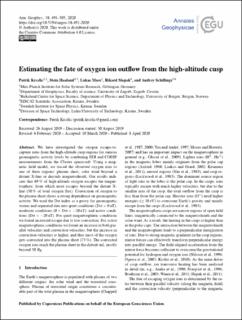| dc.contributor.author | Krcelic, Patrik | |
| dc.contributor.author | Haaland, Stein | |
| dc.contributor.author | Maes, Lukas | |
| dc.contributor.author | Slapak, Rikard | |
| dc.contributor.author | Schillings, Audrey | |
| dc.date.accessioned | 2021-04-28T08:56:36Z | |
| dc.date.available | 2021-04-28T08:56:36Z | |
| dc.date.created | 2020-06-03T20:42:04Z | |
| dc.date.issued | 2020 | |
| dc.Published | Annales Geophysicae. 2020, 38 (2), 491-505. | |
| dc.identifier.issn | 0992-7689 | |
| dc.identifier.uri | https://hdl.handle.net/11250/2740094 | |
| dc.description.abstract | We have investigated the oxygen escape-to-capture ratio from the high-altitude cusp regions for various geomagnetic activity levels by combining EDI and CODIF measurements from the Cluster spacecraft. Using a magnetic field model, we traced the observed oxygen ions to one of three regions: plasma sheet, solar wind beyond a distant X-line or dayside magnetosheath. Our results indicate that 69 % of high-altitude oxygen escapes the magnetosphere, from which most escapes beyond the distant X-line (50 % of total oxygen flux). Convection of oxygen to the plasma sheet shows a strong dependence on geomagnetic activity. We used the Dst index as a proxy for geomagnetic storms and separated data into quiet conditions (Dst>0 nT), moderate conditions (0>Dst>−20 nT), and active conditions (Dst<−20 nT). For quiet magnetospheric conditions we found increased escape due to low convection. For active magnetospheric conditions we found an increase in both parallel velocities and convection velocities, but the increase in convection velocities is higher, and thus most of the oxygen gets convected into the plasma sheet (73 %). The convected oxygen ions reach the plasma sheet in the distant tail, mostly beyond 50 RE. | en_US |
| dc.language.iso | eng | en_US |
| dc.publisher | Copernicus Publications | en_US |
| dc.rights | Navngivelse 4.0 Internasjonal | * |
| dc.rights.uri | http://creativecommons.org/licenses/by/4.0/deed.no | * |
| dc.title | Estimating the fate of oxygen ion outflow from the high-altitude cusp | en_US |
| dc.type | Journal article | en_US |
| dc.type | Peer reviewed | en_US |
| dc.description.version | publishedVersion | en_US |
| dc.rights.holder | Copyright Author(s) 2020. | en_US |
| cristin.ispublished | true | |
| cristin.fulltext | original | |
| cristin.qualitycode | 1 | |
| dc.identifier.doi | 10.5194/angeo-38-491-2020 | |
| dc.identifier.cristin | 1813716 | |
| dc.source.journal | Annales Geophysicae | en_US |
| dc.source.40 | 38 | |
| dc.source.14 | 2 | |
| dc.source.pagenumber | 491–505 | en_US |
| dc.identifier.citation | Annales Geophysicae. 2020, 38 (2), 491–505. | en_US |
| dc.source.volume | 38 | en_US |
| dc.source.issue | 2 | en_US |

